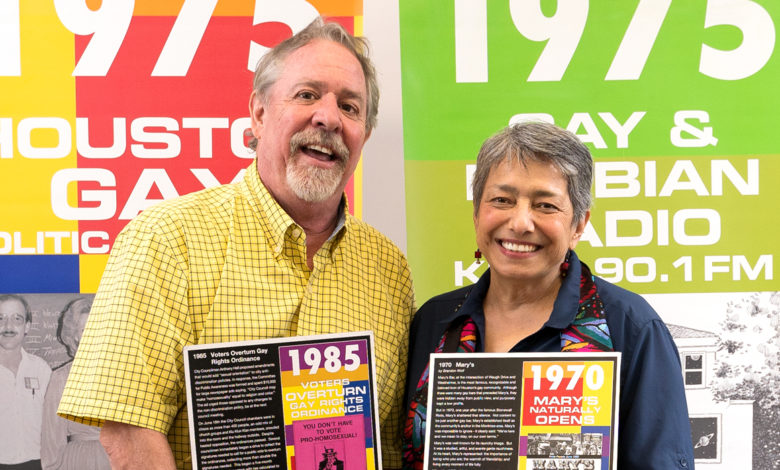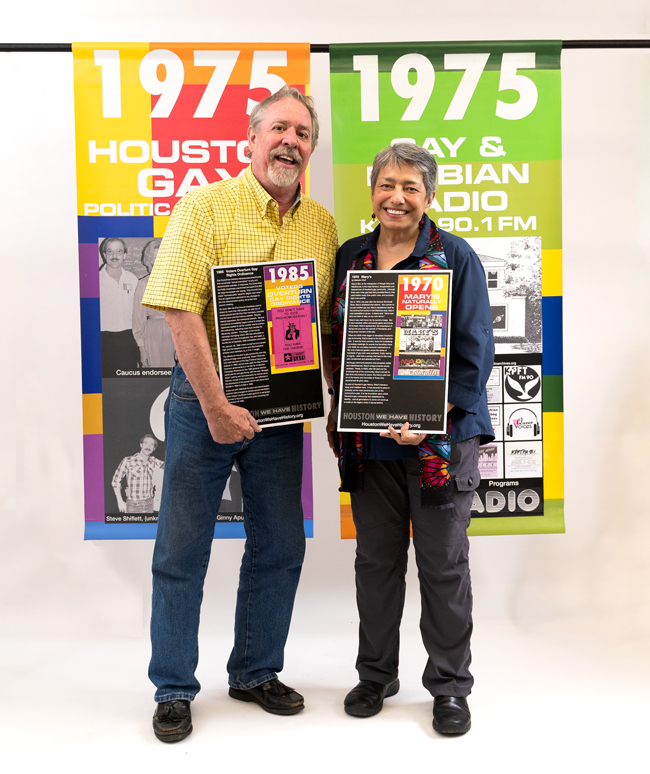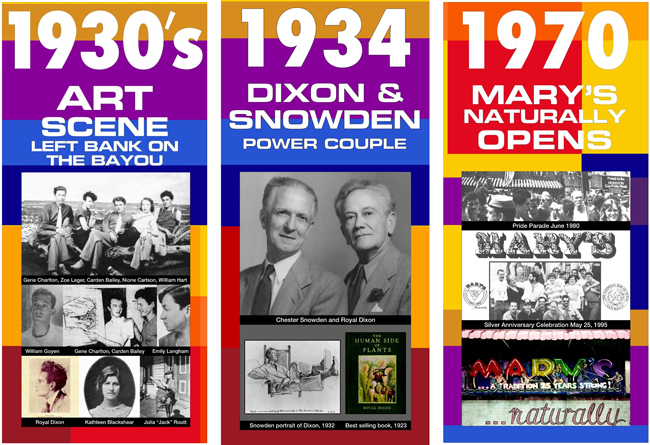
Capturing Houston’s LGBTQ History
The Banner Project creators Sara Fernandez and Kirk Baxter discuss their educational pop-up exhibit.

Houston lesbian activist Sara Fernandez was visiting museums in New York City in the spring of 2013 when she first became inspired to bring her hometown’s LGBTQ history to life.
While the exhibits she visited there were not highlighting the LGBTQ community, LGBTQ history was included in both. One exhibit documented queer life on the Lower East Side in 1993. The other featured a permanent display of 20th-century activists that included suffragettes, civil-rights icons, and gay-liberation pioneers.
After returning from New York, Fernandez shared her dream of creating a Houston LGBTQ history exhibit with the Houston Area Rainbow Collective History (ARCH), an organization that encourages cooperation among local LGBTQ historians.
Later, when it was announced that Houston would be the site of the National LGBTQ Task Force’s 2014 Creating Change conference, Fernandez attended early planning meetings and convinced the organizers to let her display a Houston LGBTQ history timeline.
“When I first learned that the project was approved, I was thrilled,” Fernandez remembers. “Shortly thereafter, there was a hurricane of thoughts: where would I find the history, who would work with me, how would we cover the costs, and was I out of my realm? I stayed motivated because I was optimistic about getting the community to support this project.”
Fernandez eventually decided to go with a visual timeline consisting of 27 banners, each one measuring about 2 feet wide and 5 feet tall. Those banners would be hung side-by-side to create an eye-catching overview of events, people, and organizations that made a difference in Houston’s LGBTQ community from 1930 to 2003.

Fernandez worked with local LGBTQ history buffs to decide on the 27 topics to feature on her banners. The topics included key events such as the controversial Anita Bryant protest in 1977 and the shocking murder of gay banker Paul Broussard in 1991. Historian JD Doyle was contacted for assistance in providing numerous photographs, information, and essays regarding the ideas. He soon became a partner of the Banner Project and developed its website.
Fernandez approached gay Houston graphic artist Kirk Baxter to design the banners. The two had met after the iconic Mary’s bar was sold. Baxter had organized a Make Mary’s Matter campaign to memorialize the popular gay bar’s history.
Baxter recalls his initial hesitation to take on the banner-design project. “At first, I was very apprehensive. I am self-employed, and this was to be a pro-bono project, which was fine, but I was extremely busy with office projects and deadlines.”
With just two weeks until the banners were to be exhibited at the Creating Change conference, a final design still hadn’t been decided on. “After talking with Sara over the phone, I realized that I needed to step up and do this for the community. Sara had talked with others, but they had restrictions. My work does involve exhibit design, so it became a natural fit.”
With the production cost of the banners estimated at $2,500, Baxter and Fernandez found the funding they needed through the Kellett Foundation and other generous community benefactors. The JD Doyle Archives has taken over the funding since 2016.
After successfully displaying their banners at the 2014 Creating Change conference, Fernandez and Kirk’s project continued to grow. The pop-up exhibit has been displayed at many LGBTQ galas, and has also been featured in the University of Houston’s MD Anderson Library each year in October since 2016. In April, the banners were displayed at the Houston Rockets’ first LGBTQ Pride Night at the Toyota Center.
The Banner Project now includes 46 banners that showcase Houston’s LGBTQ history through 2020. The newest banner celebrates the life of the late Monica Roberts, a Black trans activist and award-winning journalist who created the nationally recognized TransGriot blog.
“Thanks to Tammi Wallace and the Greater Houston LGBT Chamber of Commerce, who connected us with the Rockets, we have become more visible and demand for the banners has increased,” Fernandez says. “It is exciting to see new requests, but it’s also a bit overwhelming since there is work involved in managing the banners.”
Between exhibits, the banners are carefully rolled up in acid-free paper and placed into large packing cartons. Then they are stored in Fernandez’s closet. “That keeps the exhibit very compact,” she laughs. “I have a small closet!”
Baxter says his design work for the Banner Project feels very rewarding. “The banners have been in existence for seven years now, and have been displayed at a variety of venues. That kind of exposure gives me a sense of pride that they are being seen outside of our community,” he says. “The response has been enthusiastic!”
Fernandez, 69, was born and raised in El Paso. She moved to Houston in 1994 when her husband was transferred here for his job. She has two children and two grandchildren. Outside of the Banner Project, she is currently involved with the Association for Family and Community Integrity (AFCI) and their UnderstandingGay.org website, and is also busy recording oral histories from local LGBTQ activists.
Baxter, 65, is a native of Washington, DC. He moved to Houston in 1981 with an architectural firm he was working for. He is currently involved with The oH Project, a local collection of AIDS oral histories. He also does pro-bono graphics work for a variety of local LGBTQ groups.
Baxter says he has learned a great deal about Houston’s LGBTQ history through his involvement with the Banner Project. “I am so grateful that I took it on. It has been a very eye-opening experience for me personally, as I have come to recognize the depth and importance of Houston’s gay community to our city, and to our nation.”
Fernandez agrees. “This project gives me great joy. My feelings are a reflection of the joy and pride that I see in the faces of people who are looking at the banners. That is what the banners are about: [lifting up] members of the community, both past and present.”
The Banner Project can be accessed online at houstonwehavehistory.org.
This article appears in the June 2021 edition of OutSmart magazine.










